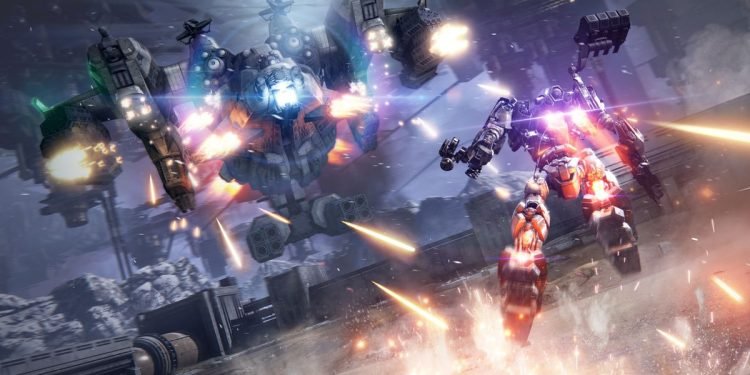During my first few hours with Armored Core 6: Fires of Rubicon — the first Armored Core game I’ve ever played — I struggled (and mostly failed) to draw parallels between FromSoftware’s new game and the ones that made it a household name. The rebooted Armored Core is not a sprawling adventure game à la Elden Ring or Bloodborne, nor does my experience with those games make me a capable mech pilot.
Instead, Armored Core 6 is a reconsideration of a classic game series infused with a decade of studio growth, expertise in combat and level design, and the heightened expectations of FromSoftware fans. Armored Core 6 is a faster, more refined Armored Core experience that streamlines the mecha franchise in clever ways.
Fires of Rubicon sends your character, a faceless, voiceless mercenary named C4-621, to the distant planet of Rubicon-3. This alien world is home to a substance known as Coral — Rubicon’s equivalent of Dune’s Melange or Avatar’s Unobtainium — which is so precious that extraterrestrial corporations fight endless wars to control it. As 621, your role in this conflict is fluid; your handler, a man named Walter, takes jobs from the competing factions of Rubicon and sends you into the field to do whatever dirty work pays the bills.
You transform your identity, such as it is, by stealing the name of another Rubicon merc named Raven. Without a real name for you, your contractors derisively call you “hound,” “tourist,” “Rb23,” “Gun 13,” and “buddy,” affirming that you are but a hired gun in this great war machine. You have many names, but you have no side. You fight for and against the corps, military forces, and rebels of Rubicon.
The closest thing you have to self-expression on Rubicon is your Armored Core, or AC. The oversized walking tank that you pilot grows and evolves over time as you unlock and purchase new parts, honing the builds that fit your particular play style. Fires of Rubicon is a game of tinkering and discovery. It’s also a game of failure; as you face down and eventually lose to more powerful ACs and other mechanized terrors, you’ll need to retreat to the game’s garage to revise your strategies. There, you can try out new assemblies: skinny, sleek, heavy, bipedal, quadrupedal, dual machine guns, heavy ordnance, and much, much more.

Players of Elden Ring or Dark Souls may be surprised by Armored Core 6’s linear, mission-based structure: Handler Walter will send 621 on a variety of chores ranging from assassinations to geological surveys to ambushes on rival factions. Complete them, and you’ll return back to base for another batch of tasks. Mission briefings only tell you a fraction of what you’ll need to know. Thankfully, the game offers consistent checkpoints should you fail your mission, plus the chance to switch up your AC’s configuration if you die. Armored Core 6 isn’t as punishing or uncompromising as previous entries, but its difficulty certainly matches that of FromSoft’s other games. (For an immense challenge, the option to replay and S-rank missions is available after completing each one.)
The depth and challenge of Armored Core 6 isn’t immediately apparent. FromSoft starts players off gently, letting them become accustomed to combat and movement at a slow pace against meager enemy forces. Only when faced with the first boss battle, a building-sized helicopter, does the complexity of Armored Core 6’s combat systems begin to reveal itself. You must quickly learn to juggle four mounted weapons, being mindful of the ammunition and reload times of each, while also managing your energy consumption and dodging swarms of exploding missiles. As in FromSoftware’s Sekiro: Shadows Die Twice and Bloodborne, aggression and patience are rewarded. But as in Elden Ring, there are very few figurative brick walls; Armored Core 6 offers alternate avenues to improve your skills and your AC components should you find yourself outclassed by an opponent.

Take the bullet-hell boss known as Balteus. This early-game AC hurls dozens of rockets at you when it’s not firing a Gatling gun and a wide-spread shotgun at you, or slashing at your AC with massive flaming swords, or filling the screen with plasma bursts. I spent a good three hours trying to fell Balteus when I should have been doing something else: replaying missions for cash to spend on new AC parts; experimenting with said parts; buying new upgrades; and honing my skills in the simulation known as the Arena. After realizing that it might be beneficial to be the aggressor in this battle, I started rocket-boosting right into Balteus’ personal space, kicking it in the face, and stabbing it with a laser sword while shrugging off the occasional missile strike. Defeating it, and Fires of Rubicon’s other massive bosses, is just as rewarding as in any other FromSoft game.
Fires of Rubicon makes experimentation easy. The clean, minimal UI makes navigating the AC assembly menus incredibly efficient. You can resell AC parts. You can save specific loadouts for later. And respeccing your AC’s operating system is simple and cheap. FromSoft has ensured that you’re never trapped while going down a particular path. It’s the developer’s most generous game to date.
The mission design is inventive throughout the main story. While many jobs send you into the field with straightforward objectives — razing military structures or destroying a rival corporation’s AC, to name a couple — levels are frequently packed with surprises. You may find yourself defending a weapon system from waves of enemies, as part of a three-person cleaning crew callously wiping out an insurrection force, or blowing up a massive laser grid while being stalked by an unseen force. Only one mission stands out as truly poor: a stealth-based level that does not fit the action-packed game design of the rest of Fires of Rubicon. Thankfully, the attempt to ape Metal Gear Solid is brief.

The narrative of Fires of Rubicon is uncharacteristically transparent for FromSoft, told through faceless, voice-based communications that speak to your character on a need-to-know basis. But it’s a story well told of capitalism and colonialism run amok. Like the rest of the game, it requires no previous Armored Core experience to enjoy.
But the most compelling aspects of Armored Core 6 come from its hard-fought battles, when 621 survives their mission with just a sliver of life left, having out-danced their opponent in the exchange of missiles, bullets, and laser beams. It’s noisy, chaotic, and starkly beautiful, all this clanging metal, ricochets, and explosions. It’s unlike many of the FromSoftware games you may have played over the past decade, to its benefit. Armored Core 6: Fires of Rubicon is the Elden Ring developer flexing an old, nearly forgotten muscle, but one that’s still strong as ever.
Armored Core 6: Fires of Rubicon will be released on Aug. 25 on PlayStation 4, PlayStation 5, Windows PC, Xbox One, and Xbox Series X. The game was reviewed on PS5 using a pre-release download code provided by Bandai Namco. Vox Media has affiliate partnerships. These do not influence editorial content, though Vox Media may earn commissions for products purchased via affiliate links. You can find additional information about Polygon’s ethics policy here.
























































